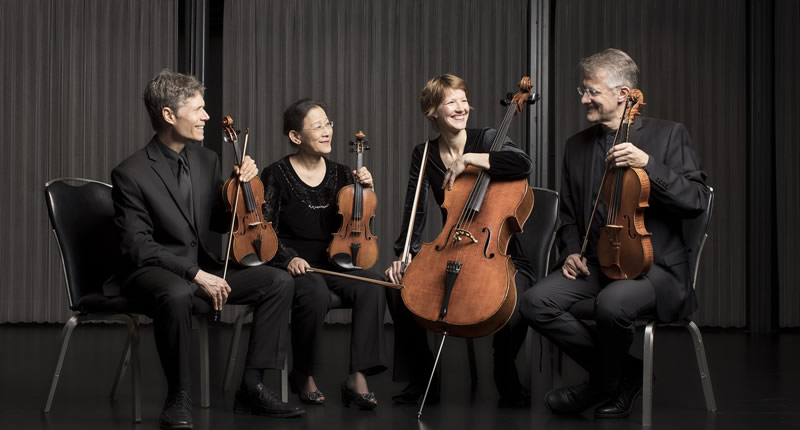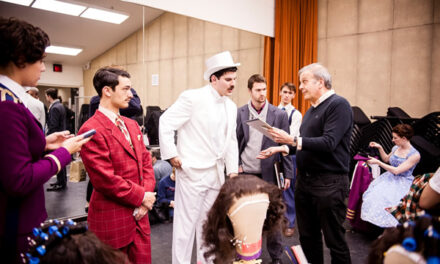So if Google translate has not let us down…. The great Ciompi Quartet – our quartet, as we’ve often written – returned in all its restored glory to the wonderful Ernest W. Nelson Music Room on Duke’s East Campus for the first of this season’s formal series offerings – four concerts in 2019-20, with presentation honors shared by Duke Performances and the Music Department. The program was titled “Trois Modernes,” and that it was. It was also very chic, very short, intense, and very, very good.
The bill of fare was Debussy, Stravinsky, and Takemitsu, but not in that order. The scores were all composed when their creators were in their 30s. Whether that means they were angry young men or not we’ll leave to the listeners to decide. Those listeners – the faithful followers of our region’s finest chamber ensemble, a group that has been enriching our lives, culturally and otherwise, since 1965, came out in relative force for this event. The Ciompi’s programming is inspired but the best kind of group-think, with no hint of any marketing and PR department lurking backstage…. We have come to trust them to treat us to the very best there can be in chamber music. It’s kind of like the guy on the English estate who was asked how he got such a beautiful lawn. Simple, he said. You seed it and fertilize it and water it and roll it and mow it – for 300 years. Our quartet hasn’t been at it quite that long, but you get the point. And even with a still-relatively-new cellist, the results are entirely favorable – in part because she spent a decade with the Lark Quartet before coming here, so she already knew lots and lots of repertory. (The Lark remains significant because the CQ’s next concert, on Nov. 24, will be a joint appearance with the cellist’s former ensemble, combined with one of its former cellists, in this, its final season.)
The concert began with the spiky Concertino for string quartet, composed in 1920 when Stravinsky was 38 – which means that, back then, he was too old still to be considered young; some would say he ought to have known better, too, than to treat instruments (and listeners’ ears) so aggressively. But the piece is of a piece with his other, better-known compositions, and it definitely commands attention from the very outset (or maybe “onslaught” is a better word) – and it’s not very long. Only one person escaped (and to tell the truth she seemed indisposed, rather than put upon). This is bigger-than-life music, virtually orchestral in scope and sweep, and the performance was a virtuoso one throughout. Riveting!
There followed Takemitsu’s “Landscape,” written in 1960 when he was 30. Violist Jonathan Bagg‘s program note was particularly useful in putting this work into the context of the program. We are reminded that the composer spent a considerable amount of his time writing about aesthetics and theory, that he was largely self-taught, and that timbre was his thing. Of course. So in “Landscape” he eschews vibrato – try playing without it, all you trained musicians out there – and thus projects mostly unvarnished lines – fragments, really – that stand out in bold relief during the (again) short run of the music. Like the Stravinsky, it clocked in at around 8.5 minutes. Intense. Very intense. (No one escaped during it.)
And then there was the Debussy Quartet, from 1896, written when he was 32. It’s everyone’s favorite chamber music work by Debussy, in part because it has fingerprints from all over all over it – it’s sort of like he threw in everything so he could later extract notions and even actual bits to recreate moods and musical ideas from these four-movements in much of his future output. And could he have known what was to come, geo-politically? That, too, is hinted at, here. And never mind this particular score’s influence on (as Bagg wrote) every other string quartet that followed it.
The artists that make up the Ciompi – violist Bagg, recent recruit Caroline Stinson, cellist, and stellar violinists Eric Pritchard and Hsaio-mei Ku – had this music totally under their fingers (which is not to suggest they weren’t also complete masters of the other music played here). We’ve heard them bring the Debussy to life fairly often. This reading was as exceptional as any of the others, to be sure – and the memory of it will without doubt linger long in the minds of those who were present.
The Ciompi Quartet will repeat the Takemitsu and the Debussy during its Nov. 10 concert for CMR at the NCMA. For details, click here.
As noted above, their formal Duke season continues Nov. 24. For details, click here.












